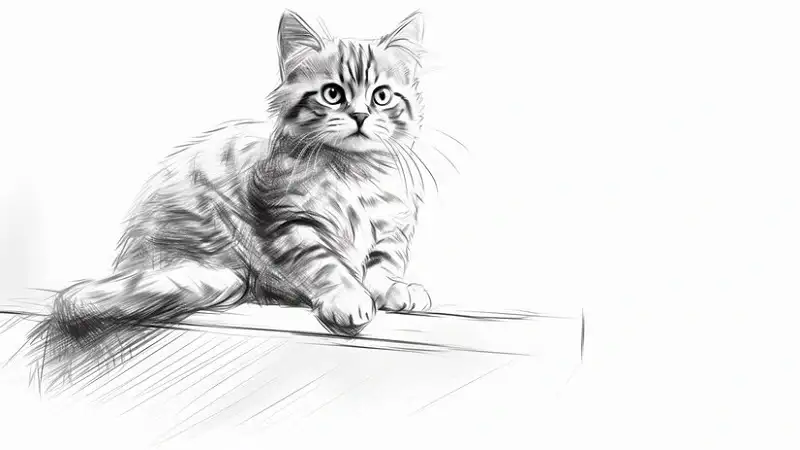Drawing:a4z_-ymtkr8= Cats is one of the most versatile and rewarding forms of art. It allows you to capture the essence of a subject and express your creativity in endless ways. Among the myriad of subjects to draw, cats hold a special place in the hearts of artists. Their grace, charm, and expressive personalities make them an ideal muse for beginners and seasoned artists alike.
Understanding Cats as an Art Subject
The Charm and Elegance of Cats
Drawing:a4z_-ymtkr8= Cats have an undeniable allure. From their sleek movements to their captivating eyes, they embody elegance and mystery. Their flexible bodies and unique fur patterns provide an endless source of inspiration for artists.
Symbolism of Cats in Art History
Drawing:a4z_-ymtkr8= Cats have been featured prominently in art for centuries, symbolizing everything from independence to mysticism. In ancient Egypt, they were revered as sacred animals, while in modern art, they are often depicted as symbols of comfort and companionship.
Tools Needed for Drawing Cats
Basic Tools for Beginners
If you’re just starting, all you need is a simple set of pencils, an eraser, and Drawing:a4z_-ymtkr8= Cats paper. A basic sketchbook is perfect for practicing.
Advanced Tools for Professionals
For more detailed and professional work, consider adding colored pencils, fine liners, and blending tools to your collection. Digital drawing tablets are also excellent for creating cat art with precision.
Pencil Types and Their Uses
- Graphite Pencils: Ideal for sketching and shading.
- Charcoal Pencils: Perfect for adding depth and texture.
- Colored Pencils: Great for capturing the vivid fur patterns of different cat breeds.
Paper Choices
- Textured Paper: Provides grip for shading tools, ideal for realistic fur effects.
- Smooth Paper: Best for detailed line work and clean finishes.
Getting Started: Sketching the Basic Form
How to Start with Shapes
Begin by breaking the cat’s body into basic shapes. Use circles for the head and torso, and lines to mark the limbs and tail. This foundation helps maintain proportions.
Building the Anatomy of a Cat
Pay attention to the natural curves of a Drawing:a4z_-ymtkr8= Cats body. Cats are known for their fluid movements, so avoid rigid lines.
Step-by-Step Guide
- Drawing the Head: Start with an oval and add guidelines for the eyes, nose, and mouth.
- Adding the Body and Limbs: Use overlapping circles and lines to connect the head to the torso.
- Incorporating the Tail: Draw the tail as a flowing extension of the spine.
Adding Realism to Your Drawing
Techniques for Shading and Texture
Shading is essential to bring your cat to life on paper. Use cross-hatching for short fur and blending techniques for soft, fluffy areas.
Capturing Lifelike Eyes
The eyes are the soul of your drawing. Use light reflections to make them look lively and expressive.
Experimenting with Different Styles
Cartoon vs. Realistic Drawing
While realistic drawings focus on details and textures, cartoon styles emphasize exaggerated features for a playful look.
Benefits of Exploring Styles
Trying different styles helps you discover your strengths and expand your artistic abilities.
Common Challenges in Drawing Cats
Proportional Issues
Maintaining accurate proportions can be tricky. Practice drawing cats from various angles to improve.
Achieving Fur Texture
Fur requires patience. Use short, deliberate strokes to mimic the direction and flow of the fur.
Solutions to Overcome Challenges
- Use reference images for guidance.
- Practice specific techniques like fur shading and anatomical sketches.
Tips for Drawing Cats with Personality
Cats are full of personality, and your art should reflect that. Observe their behavior, expressions, and quirks to add individuality to your drawings.
Using Digital Tools for Cat Drawings
Popular Drawing Software
Apps like Procreate, Adobe Fresco, and Krita are fantastic for digital art.
Features to Look for in Software
Choose tools with customizable brushes, layers, and pressure sensitivity for a natural drawing experience.
Inspiration Sources for Cat Drawings
Observing Real Cats
Spend time watching cats in action to understand their movements and expressions.
Studying Famous Cat Artworks
Look at works by renowned artists who have drawn cats for inspiration and technique ideas.
Enhancing Your Skills Over Time
Participate in art challenges and seek constructive feedback from online communities to refine your skills.
Final Touches for a Professional Look
Add backgrounds or subtle details like whiskers and shadows to elevate your drawing.
Conclusion
Drawing:a4z_-ymtkr8= Cats is a delightful and rewarding endeavor. With the right tools, techniques, and a little patience, you can create stunning artworks that capture their unique charm. So grab your pencils or digital tablet, and let the creativity flow!
FAQs
- What is the best pencil for drawing cats?
Graphite pencils are great for sketching, while colored pencils work well for fur details. - How can I make my cat drawings look realistic?
Focus on shading, proportions, and capturing the eyes’ liveliness. - What are the most common mistakes in drawing cats?
Proportional errors and over-simplified fur textures are frequent challenges. - Should I use a reference photo for my drawings?
Yes, references help improve accuracy and understanding of anatomy. - How can I improve my shading techniques?
Practice different methods like cross-hatching and blending, and experiment with various pencil grades.
